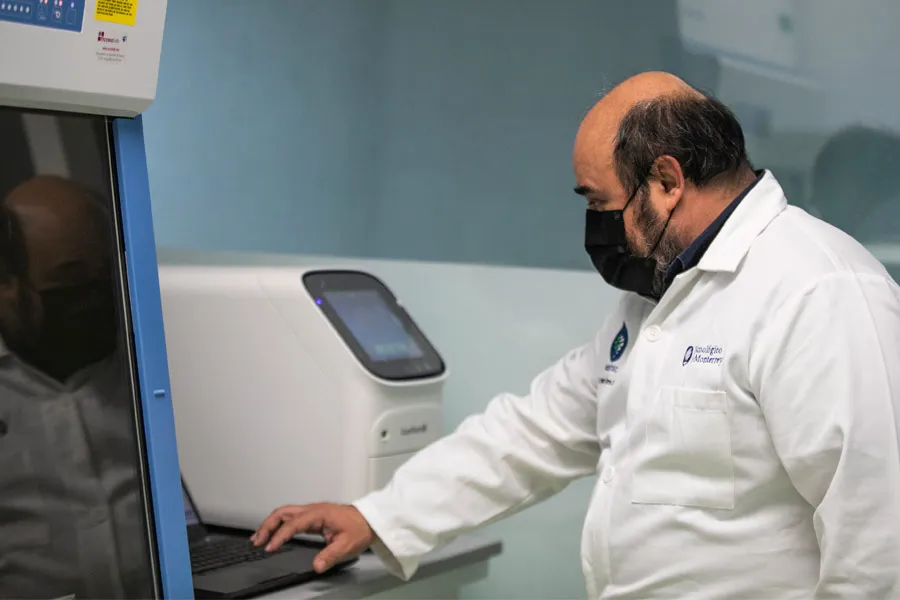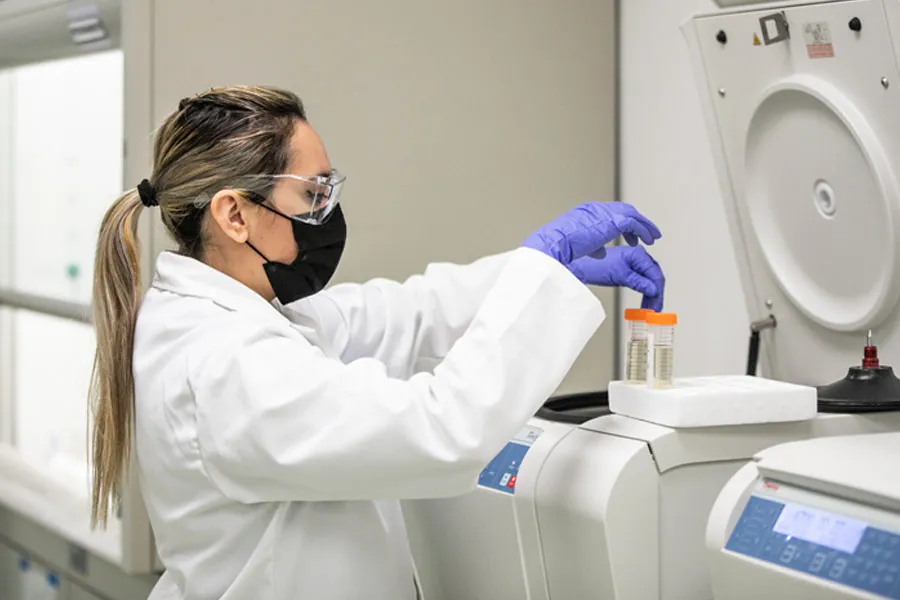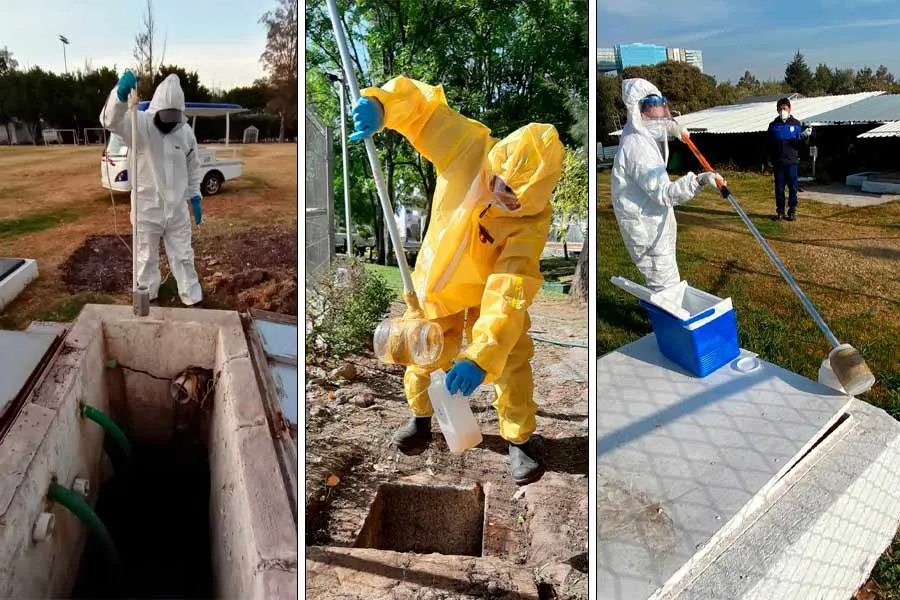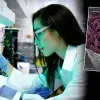By analyzing wastewater with molecular technology, the aim of Tec de Monterrey’s Wastewater Monitoring Laboratory (MARTEC) is to detect multiple outbreaks or infections of COVID-19 in advance.
When MARTEC was presented at the 51st Research and Development Conference, Rector and Executive President of the Tec David Garza highlighted the work of researchers from the institution in combating the pandemic.
“This project touches on several of the principles that were defined by the Tec at the beginning of the pandemic: acting to take care of the health and integrity of the community, providing continuity of operations, and making everything we do available to society,” he said.

This laboratory is located on the Tec’s Monterrey campus and has the capacity to efficiently serve the rest of the institution’s campuses, providing alternative support for the conscientious return.
The laboratory uses PCR technology to detect whether groups of people are carrying the SARS-CoV-2 virus and even specifies their location before they present any symptoms, said Dr. Roberto Parra, who runs the laboratory.
During the inauguration, which was held virtually, it was highlighted that MARTEC will be a valuable tool for mitigating infections, as well as being an instrument for decision-making that is backed by scientific evidence.
Detecting the presence of SARS-CoV-2 in wastewater
The laboratory director highlighted that the Tec has not only developed an innovative system to detect the presence of the virus in wastewater but has also created action protocols which will allow the institution to make decisions based on the results.
“Work on this has been done at other universities, but since it is already up and running at Tec de Monterrey, I could say that we are pioneers. Unlike anyone else currently, TecSalud has managed to combine efforts in the areas of water and health,” he emphasized.
The team includes expert researchers in molecular biology, physics, chemistry, microbiology, environment, and COVID-19 detection such as Dr. Eduardo Sosa, Dr. Elda M. Melchor, Dr. Mariel Oyervides, Dr. Manuel Martínez, Professor Itzel López, and engineers Laura Rodas and Sofía Lucero.
The program started out as a joint project between the Tec and Arizona State University (ASU), where samples collected from campuses were sent. With this laboratory, the process can now also be carried out at the Tec.
The use of molecular technology
Dr. Oyervides said that they could know whether SARS-CoV-2 was present in wastewater by detecting the virus’ RNA through the use of RT-qPCR (Reverse Transcription Polymerase Chain Reaction) molecular biology technology.
“Although the concentration of the virus’ RNA is very low due to the volume of water from the campus, it can be detected with this technology by using a device known as a thermocycler,” the researcher said.

Oyervides explained that a PCR test is carried out in real-time to amplify the RNA sequences of the virus, thus allowing it to be detected in the wastewater network, and allowing for the level of the virus to be quantified.
“This means we can determine if the virus is present on campus or even in a building, which is what we have been doing at the Tec,” said the doctor.
“It’s frontier technology that allows us to concentrate, purify and amplify the signal of the forensic fingerprint left by the virus’ RNA,” added Dr. Parra.
In order to carry out this analysis, it is necessary to take a sample of the wastewater that can be extracted from treatment plants or manholes on campuses. Then it needs to be processed and taken to the laboratory for testing.
RNA analysis is then performed on the sample. This is because SARS-CoV-2 itself cannot be detected as it decomposes in wastewater.
Dr. Parra: “We’re taking care of the health of our community through science and technology. It’s a privilege to be able to this at Tec de Monterrey.”
Actions to reduce the risks
As part of the methodology to measure the risk of infection, a traffic light system has been implemented according to the number of RNA copies per liter of wastewater, explained Dr. Eduardo Sosa.
“It is a system that was first implemented at Clemson University and consists of five levels,” he added.
“Clemson University was able to quantify virus levels using this system, but we’re going one step further by using it as a trigger for different response protocols depending on the level of risk,” says Dr. Manuel.
Different teams have been formed at the Tec that work together to implement actions including cleaning spaces, traceability, identifying possible carriers, performing surveys, and doing PCR tests, all with a view to breaking the chain of infections.
A shield for the Tec against COVID-19
Engineer Sofía Lucero said that the the MARTEC program is currently being implemented in 23 of the institution’s campuses, but as face-to-face activity increases, it will soon be extended to all Tec campuses,
“We started on September 18 at the Monterrey and Guadalajara campuses and PrepaTec Santa Anita,” said Lucero.
“Samples are taken every week on Fridays. Depending on the federal warning level and also the number of people there are, we’ll decide whether to take them every week or every two weeks,” added Dr. Oyervides.
The samples are collected by physical plant staff for each campus who have the appropriate safety equipment and are trained by MARTEC staff.
“They are told at what time more or less to take the samples, how to take them when most people are working, and how the personal protective equipment should be used so that they can take the sample safely and correctly,” said the doctor.
After the sample is taken, it’s frozen and sent to the laboratory for processing. In total, it takes about four days from when the sample is drawn until the results are obtained, she added.
This process makes it possible to identify a possible outbreak seven to ten days before it occurs.
Physicians from the Primary Care Modules (MAP) at each campus, coordinated by national leader Dr. Martín de la Cruz, use the information provided by MARTEC on traceability processes to stop the chain of transmission.
“Work will also soon be starting with Tecmilenio, the idea being to integrate all high schools and even other institutions such as companies and other educational institutions in the future,” Dr Melchor shared.

Monitoring cities to fight disease
Since 2017, Dr. Parra, Dr. Sosa, and other researchers have been working on an Urban Metabolism project that monitors wastewater, allowing them to learn about various activities in urban areas.
“Dirty water is a very interesting tool to keep track of what is happening in the city,” said the director.
As part of their project, the researchers began working with governments and other institutions, and even obtained funding to carry out the work.
With the arrival of the pandemic, the researchers adapted their project and developed methodologies to specifically detect the RNA of viruses, which are now applied in the MARTEC Laboratory.
“This laboratory is exclusively for SARS-CoV-2 or viruses in general and it has the capacity to provide follow-up. For example, we can detect new strains or variations of the virus,” he stated.
Dr. Parra said that there are two unique points to highlight about the MARTEC project: to help break the chain of transmission of the virus and to help reactivate activities.
“One is that it gives you information eight to ten days before you have an outbreak, maybe up to 14, i.e. you can detect it when it begins, which gives decision-makers the opportunity to initiate actions to break the chain of transmission.
“The second point is that it is not invasive. You don’t need to stop an entire community to do tests everywhere and detect if there’s an outbreak in any building, something which is logistically, economically, and practically unworkable,” Parra pointed out.
YOU’LL DEFINITELY WANT TO READ:





